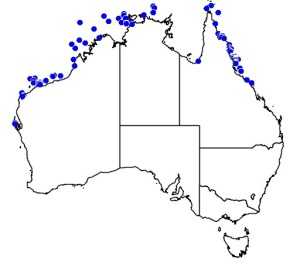�
�

©Lyle Vail and Anne Hoggett: Comatula rotalaria in 15 m depth off Osprey Islet. Typical "resting on elbows" posture.
�
���
Comatula rotalaria

©Lyle Vail and Anne Hoggett: Comatula rotalaria in 15 m depth off Osprey Islet. Typical "resting on elbows" posture.
Kingdom
Animalia
Phylum
Echinodermata
Class
Crinoidea
Order
Comatulida
Family
Comatulidae
Genus
Comatula
Species
Comatula rotalaria
Distinguishing features
Comasterids are distinguished from all other featherstar families by having terminal segments of the oral pinnules modified to form a comb. Comasterids also have a distinctive "feel" due to well developed hooks on most pinnules that cause them to cling like velcro.
Comatula rotalaria adults have up to 20 arms. In immature specimens, alternate arms are reduced in size (Clark and Rowe, 1971). Cirri are absent or rudimentary. Colour is dark all over.
Size
- Size data has not been obtained.
Depth range
- Depth range data is not yet available.
Synonyms
Distribution
Distribution and habitat preferences
Comatula rotalaria is found only in soft-bottom habitats deeper than 12 m.
At Lizard Island, this species is known only from off-reef areas in water deeper than 12 m on the western side of the island group.
Web resources
References
- Clark, A.M. and F.W.E. Rowe (1971). Monograph of shallow-water Indo-west Pacific echinoderms British Museum (Natural History), London.
- Lowry, J.K. and B.A.R. Azman (2008). A new genus and species of cyproideid amphipod associated with unstalked crinoids on the Great Barrier Reef, Australia, Zootaxa, 1760: 59-68. LIRS catalog number 1186.
- Messing, C.G., D.L. Meyer, U.E. Siebeck, L.S. Jermiin, D.I. Vaney and G.W. Rouse (2006). A modern soft-bottom, shallow-water crinoid fauna (Echinodermata) from the Great Barrier Reef, Australia, Coral Reefs, 25: 164-168. LIRS catalog number 956.
